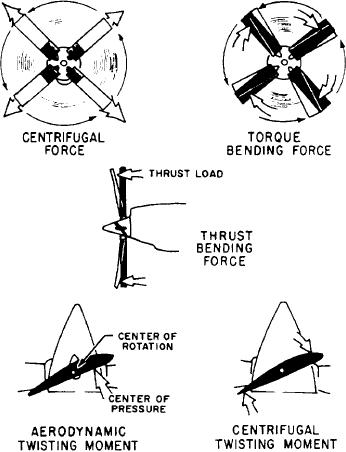
BASIC PROPELLER OPERATION
the engine load and the propeller takes a larger
bite of air. This function will keep the turboprop
engine at 100-percent rpm.
The first propellers were fixed-pitch and
On constant-speed propellers, the blade angle
designed mainly to get the aircraft off the ground.
must be adjusted to provide the most efficient
The pitch (blade angle) was small so that the
engine could quickly turn over to its full rpm and
angle of attack at all engine and aircraft speeds.
The most efficient angle of attack is very small;
use its full horsepower for takeoff. Once an air-
it varies from 1 to 4 degrees positive angle. The
craft with a fixed-pitch propeller of low blade
actual blade angle necessary to maintain this small
angle is in the air, forward speed of the aircraft
is limited. The low blade angle allows the propeller
angle of attack varies with the forward speed of
to turn too fast to take a big enough bite of the
the aircraft. With constantly increasing aircraft
onrushing air. As a result, the engine must be
speeds and high-altitude operations, it is necessary
throttled to prevent excessive overspeeding.
to have a wide range of blade angle settings. This
range of settings must adapt the propeller to
The first improvement over the fixed-pitch
propeller was the ground adjustable-pitch type.
conditions encountered in takeoff, climb, and
On this type, the blade angle (pitch) could be
cruising.
changed or adjusted on the ground by manually
FORCES ACTING ON
twisting the blades in the hub to the desired angle.
THE PROPELLER
When the angle was increased to improve cruising
One of the main requirements of any propeller
conditions, takeoff conditions suffered. An air-
craft taking off from the ground with the
is its ability to withstand severe stresses. We will
propeller at a high blade angle position is much
discuss these stresses, which are greatest near the
the same as setting a car into motion in high gear.
hub, in the following paragraphs. Figure 8-12
The engine is not able to produce full horsepower
shows the forces acting on propeller blades.
because the high blade angle loads the propeller
too much to enable it to turn over at the full rpm
of the engine.
The next design was the two-position pro-
peller. It enabled a pilot to use a low blade angle
(high rpm setting) for takeoff, climb, and
necessary operational acceleration. The pilot
could then change the propeller blade angle in
flight to a higher blade angle (low rpm setting)
for cruise. With this propeller, full engine rpm
could be developed for takeoff. Aircraft speed
could be increased at cruise with a decrease in
engine power because the high-pitch propeller
takes larger bites out of the air. The two-position
propeller did not, however, produce the most
efficient and economical use of engine horsepower
for all of the numerous intermediate flight
conditions encountered by aircraft.
Constant-speed propellers were eventually
designed to maintain a preselected rpm auto-
matically. Suppose the aircraft is heading into a
gradual climb. The constant-speed propeller main-
tains the selected rpm automatically by turning
the propeller blades to a lower angle. That is, the
propeller takes a smaller bite of air when the load
on the engine is increased. Now, should the air-
craft assume a nose-down attitude, the propeller
blades move automatically to a higher blade angle;
hence, the propeller takes a larger bite of air. In
other words, increase the load on the engine and
Figure 8-12.-Natural forces acting upon propeller blades.
the propeller takes a smaller bite of air. Decrease
8-11

